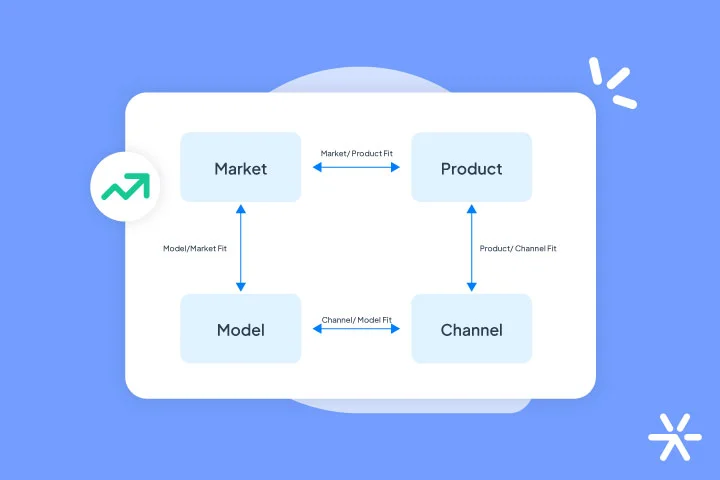What is CTR and how can your team improve it?
One of the most important metrics in Digital Marketing is the CTR — or Clickthrough Rate .
CTR is a metric that determines the impact of your CTAs within the campaigns you launch. Monitoring it is essential to understand whether your efforts are really having results.
There are several ways to analyze CTR, as it is not an independent metric. It will always be linked to a specific campaign.
And as there are campaigns and campaigns, in addition to offers and offers, analyzing CTR is work done on an individual level most of the time.
But of course: every action and every adjustment informs others, successively, as it should be in digital marketing.
Today the subject is CTR. Let’s talk about your main concerns, and also analyze stocks that need good CTRs to perform well.
Shall we get started?
What is CTR?

CTR is an acronym that stands for Clickthrough Rate .
Basically, it indicates how many people clicked on a specific CTA within a campaign.
Let’s take a quick example: you send an email, and in that email, include a button for the person to click and take advantage of the offer you are offering.
The CTR of this email will indicate how many people actually clicked on that button.
For this calculation to be created, it is also necessary to analyze the email opening rate , in this specific case.
This is because only people who opened your email will click on the CTA.
In some other campaigns, it is also necessary to analyze some other metrics to better inform the CTR calculation, which we will analyze below.
But in short: CTR indicates how many people clicked on your offer and had contact with what you are offering there.
The next metric for analysis, within this same axis, is CRO. It will indicate how many people are actually converting on your business objectives, not just clicking on your CTAs.
We have a really cool text about this. Follow the link! And now let’s talk about how to calculate CTR.
How to calculate CTR
Calculating CTR is not very complicated. In fact, it’s quite the opposite.
To calculate CTR, you need to do the following math:
(Number of impressions / number of clicks)
The information that makes up this calculation will vary greatly depending on what analysis you are doing.
“Impressions” relates to your Google Ads and Social Ads efforts . This metric indicates the number of people who received your ads.
But it is not suitable for email marketing , for example. In this case, it doesn’t matter so much how many people your emails were delivered to, but rather how many people opened your email.
Of course, with some caveats: you need to know if your email is reaching your leads. If he isn’t, then the problem is much deeper.
Due to these small differences in the analysis, I have separated below how to closely monitor CTR in campaigns where it is most needed.
In which types of campaigns is it important to evaluate CTR?

You will need to analyze the CTR in campaigns that have clickable CTAs. This is the universal basic point for CTR.
This goes beyond digital marketing, you know? For example: if you place a billboard with a QR Code in the middle of the city, analyzing the CTR means analyzing how many people opened the QR Code.
And the calculation, in this case, will analyze the estimated average number of people who see your billboard divided by the people who clicked on the QR Code.
The calculation is suitable for any occasion, as long as there is an action that your prospect , lead or customer needs to take. Ultimately, CTR is less about “clicking” and more about completing that action.
But within digital marketing there are some types of campaigns where CTR takes on a huge role, becoming the main analysis metric.
Let’s talk about them below.
Email is one of the actions that most needs constant CTR analysis, largely because it needs people to click on its CTAs to be effective.
The CTR calculation in email marketing is done by dividing the number of emails opened by the number of people who clicked on the CTA.
In other words: how many people opened the email and even clicked on the offer you made available. This first metric is the open rate.
The opening rate itself has a great influence on the CTR of email marketing, but when you deal with percentage metrics, it can be difficult to analyze the absolute results.
For example: your CTR is 7% in an email campaign. Excellent! But how many people clicked?
In the case of emails, which deal with a smaller number of people than Social Ads, for example, knowing these absolute numbers is important to stay on top of what is really happening.
SEO
In SEO work, CTR will tell you how many people are clicking on your conversion opportunities on your website and blog.
On the website, we can think of some simple conversion opportunities:
- How many people engaged with your chatbot to generate leads;
- How many people clicked on your “test now” button;
- How many people clicked any button, actually;
- How many people interacted with a presentation video;
- How many people clicked on your pricing page ;
Anyway: how many people clicked on any conversion opportunity offered by your website.
In the case of blogs, it’s the same thing, but now with an extra feature that matches the format very well: banners.
This text has some banners, as you may have noticed. These banners lead to other materials, generally available on a Landing Page with a chatbot configured for conversion.
We need to measure the CTR of these banners to know which materials receive the most clicks while reading. This way, we can understand whether the strategy of adding banners is viable.
And also for comparison. In fact, this is a very important point of CTR: the possibility of measuring what is going right with what is going wrong, and then making adjustments.

Paid Media
In paid media, it is extremely important to measure the CTR of any campaign on any channel.
In fact, this measurement, as simple as it is, comes with an extra: you keep an eye on everything that’s happening in your campaigns, and you can catch little problems that you wouldn’t catch if you just left them there.
To measure CTR on paid media, simply divide the number of impressions your ad had with the number of clicks.
Important: impressions are different from reach. This second metric, very present on Facebook and Instagram, indicates how many unique people were impacted by an ad.
That is, how many accounts saw your ad.
For CTR, what matters is Impressions. They will indicate how many times your ad appeared to users, regardless of whether it was just once or ten.
We measure it this way because part of the job of paid media is to expose people to ads until they click. And most of the time, they won’t click as soon as the ad appears.
What are good CTR values?

So far we have been discussing the importance of CTR and how to calculate it, two more operational parts of digital marketing work, right?
But how exactly do you know if your CTR is good? Are there rates that determine whether it is good or bad?
Well, it’s always good to think about the specific side first, before generalizing. The ideal CTR for your brand is one that is trending upward.
CTR percentages are very volatile depending on the conversion rate of each market segment.
In the Lead Generation Panorama 2024, for example, we found completely different values in conversion between the almost 20 sectors we analyzed.
In other words: if the conversion rate is different in each segment, the CTR will also be different, since to convert your prospect they first need to click on what is being offered.
Due to this volatility, it is best to analyze trends and determine a goal to find the ideal CTR for your market.
However, looking at the percentages themselves, we can get a more generalized idea of your click-through rate:
- 🔴 Between 0% and 1% — a rate considered bad, indicating that, on average , your ads are not being clicked on enough. This is for any campaign, on any channel, and even outside of paid media. It’s a red alert situation!
- 🟡 Between 1% and 5% — a rate considered average. You are not on alert, but the closer you are to 1%, the more important it will be to look for alternatives to improve your CTR. Don’t worry, we’ll talk about this later in this text.
- 🟢 From 5% upwards — a rate considered good, and when it exceeds double digits, it is considered excellent. But rates like this are rare, and usually indicate materials that are very necessary for the lead.
In any case, what really matters is studying your segment and your operation to understand which CTRs are most suitable for your specific reality, ok?
But talking about analyzing metrics and how CTR fits into your strategies, we also need to talk about another topic quickly.
Is CTR a vanity metric?

No, CTR cannot be considered a vanity metric at all.
But there are situations where just analyzing the CTR is not enough. We already talked about one of them just now: the case of emails and their opening rate.
Let’s assume your CTR is at 10%: great, right? But as you can see, this is a percentage.
And this percentage is built on the ratio between the number of people who opened the email and the number of people who clicked on at least one link within it , right?
Well: how many people opened the email? If there were only 10 and you sent it to a base of 1000 people, just knowing the CTR is no use: the open rate affected the results of that campaign.
If only 10 people opened the email, one of them clicked the link. But if 200 people had opened it, the CTR percentage won’t change that much — 20 people would have clicked on the link.
So, it’s not that CTR is a vanity metric. In fact, I don’t even believe that vanity metrics exist.
What exists are metrics that perfectly explain some situations, but do not explain others.
In other words: “vanity metrics” are, in fact, another name for metrics that are inappropriate for that moment and that specific measurement.
How to optimize CTR for each type of campaign

Well, now that we’ve talked more about CTR in the various types of campaigns, we also need to talk about how to improve it in each of them.
This is also a very abstract work. Nothing in digital marketing is exact, because digital marketing is not an exact science.
It only becomes accurate when you are dealing with data. So, the first suggestion to improve your CTR is to capture and organize this data.
The data is the CTRs themselves of all the campaigns you run. To start improving it, it is essential to understand whether it is increasing, decreasing or stationary.
If you don’t already have this data, you can now put all the tips below into practice, but don’t expect immediate results — you are gathering data.
Now, if you already have the information you need, you can go straight to applying these points that we will see together now.
The CTR in the email is determined by the clicks on links or buttons present in it.
So, the first tip to improve it is to increase opportunities.
It is quite common to find emails with text – text – text – button – text. Everyone already knows this structure, there is no curiosity.
That’s my offer. If you liked it, click this button. It’s all so standard that the person will only click if they are really interested in the offer.
This is the biggest problem with low CTR in emails: they do not arouse the curiosity of those who are reading and receiving the offer.
The best solution is to invest heavily in good copywriting so that your email awakens this curiosity, and include other resources that will also stimulate it.
Links to research published on your blog that complement your offer. Links at the end with related products. Several CTAs, arranged throughout the email and at least one before the first fold.
These are simple points but they greatly change the situation with low CTR in emails. But by far, what helps the most is copywriting.
SEO
Speaking of blogs, the best way to increase CTR is to offer more conversion offers.
Remembering that, in the case of a website, the CTR is indicated by the number of people who clicked on at least one of its links.
This is similar to what we understand as bounce rate: people who leave the site without clicking anything. They read and leave.
Due to this characteristic, everything is a link on a website. Services page, pricing, products, categories: everything is a link.
If the person doesn’t click on any link, your CTR will drop. It’s natural.
It is important to analyze the reasons why they do not click on these links, banners and conversion opportunities to increase CTR. They often include:
- Website usability is low;
- Links are hard to find;
- The menus are not flashy;
- The blog has few banners;
- There is no chatbot installed;
- The website copy is not optimized;
- The site is very slow overall;
Among other more specific questions, focused on the reality of your website.
Search Ads
Search ads are the most popular form of Google Ads. They are those sponsored results, which appear before the first positions in the search engine.
They have some features of their own. Every ad on the search network consists of:
- Title;
- URL;
- Descriptive subtitle.
The format is very limiting, so understanding the CTR in these ads is simpler. Any of these points have a problem. You just need to find out which one!
Social Ads
Social Ads are more complex than ads on the Search Network, largely because they involve creatives.
And it is precisely in these creatives — and in the caption that accompanies the ads — that the danger lies.
A good creative is capable of greatly increasing your CTR. But a bad creative does the opposite, and does it with much more force.
The only way to keep your Social Ads with good CTRs is to test. Avoid advertising in a single version, always do A /B testing to understand which creative had the best results.
I hope this text helped you better understand what CTR is and how it is applied to the most different functionalities of your digital marketing!
One of the best ways to increase this CTR is by working with Conversational Marketing.
Through customization, you can achieve much higher click-through rates on your website, as the approach becomes proactive.
In this article you will find out more about the strategy and everything it represents. I’ll wait for you there, okay? Thanks for reading!








